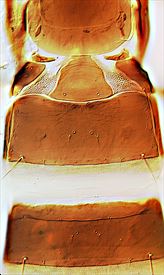Distinguishing features
Both sexes micropterous (female rarely fully winged). Body legs and antennae brown to dark brown; tarsi slightly paler, antennal segment III pale at extreme base, sometimes entirely pale. Head elongate, slightly constricted behind eyes and at base, with faint lines of sculpture near base; ocelli well developed; compound eyes larger dorsally than ventrally; postocular setae pointed; maxillary stylets about one-third of head width apart, retracted nearly to postocular setae; maxillary bridge stout. Antennae 8-segmented; segment III with 2 sense cones, IV usually with 2 (rarely 3). Pronotum major setae pointed, anteromarginal and anteroangular setae short; basantra present. Mesopresternum broadly boat-shaped, metathoracic sternopleural sutures reaching almost halfway to hind coxae. Fore tarsal tooth present. Fore wings parallel-sided, with no duplicated wing cilia. Pelta faintly sculptured on anterior margin; tergites II–VII each with 1 or 2 pairs of almost straight wing-retaining setae; tergite VIII with postero-angular and posteromarginal setae acute; tergite IX posteromarginal setae acute, nearly as long as tube. Macroptera with fore wings pale but shaed around sub-basal setae; wing-retaining setae well-developed.
Male similar to female microptera, tergite IX posteromarginal setae S2 short, stout.
Related species
Four species from New Zealand are placed in the genus Apterygothrips, but the 40 species currently placed in this genus possibly do not represent a single phylogenetic lineage. These species are similar to species of Haplothrips, but have only two or three sense cones on the fourth antennal segment, instead of four, the tergal wing-retaining setae are weak or absent, and the fore wing, if present, lacks duplicated cilia and is scarcely constricted medially. The third antennal segment bears two sense cones in A. viretrum but in the other three Apterygothrips species from New Zealand this segment bears only one sense cone. Moreover, A. viretum can apparently be distinguished by the presence of metathoracic sternopleural sutures.
Biological data
Apparently living in association with Juncus species
Distribution data
Known only from New Zealand (AK, TK / NN, SD, MB, KA, BR, MC, MK, CO, SL).
Family name
PHLAEOTHRIPIDAE, PHLAEOTHRIPINAE
Species name
Apterygothrips viretrum Mound & Walker
Original name and synonyms
Apterygothrips viretrum Mound & Walker, 1986: 44
References
Mound LA & Walker AK (1986) Tubulifera (Insecta: Thysanoptera). Fauna of New Zealand 10: 1–140.


